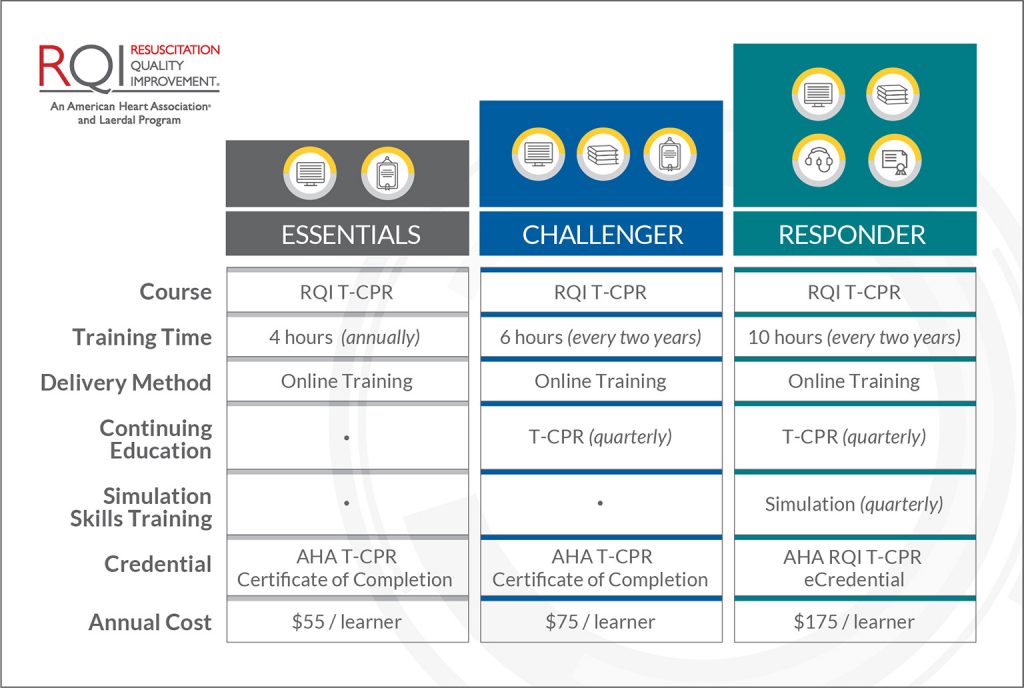RQI is committed to providing telecommunicators with the most effective training to improve and maintain their telecommunicator CPR (T-CPR) skills.
Taking into account the budget and staffing constraints so many ECCs face today, the three-tiered RQI T-CPR program is designed to offer life-saving training solutions that meet the needs of any system. Here you’ll find answers to some of the most common questions about the program.
1. What’s unique about T-CPR training from RQI?
RQI T-CPR is the performance improvement program from the American Heart Association (AHA) that supports mastery of high-quality T-CPR skills. It’s the only program vetted by AHA scientists and educators and is regularly updated and improved using expert reviews and the latest AHA Guidelines for CPR and emergency cardiovascular care (ECC).
RQI T-CPR is derived from the nationally recognized, evidence-based 2020 AHA Guidelines for CPR and Emergency Cardiovascular Care (ECC), the official resuscitation guidelines used by all training providers. It also meets the requirements of NHTSA CPR LifeLinks, as well as any state-mandated T-CPR education.
In addition, the RQI T-CPR Responder program is recognized by the International Academies of Emergency Dispatch (IAED) as the preferred solution to build and increase competence in rapid recognition of both out-of-hospital cardiac arrest (OHCA) and initiation of high-quality telephone CPR instructions. The IAED has participated in a comprehensive review of the RQI T-CPR program, including collaborating in the development of exclusive content for Priority Dispatch users.
2. My ECC already has a cardiac arrest protocol—why do I need to change?
The effectiveness of any ECC protocol for delivering bystander CPR is dependent on the confidence and competence of the telecommunicator following it. Just as first responders in the field continually practice to improve their core critical skills, public safety telecommunicators benefit from ongoing competency-based training to develop and maintain their skills, especially those that aren’t frequently used. Every link in the chain of survival must be strong, and the RQI T-CPR program makes sure that this includes the telecommunicator, the first first responders to deliver care to a patient in cardiac arrest, and coach the lay rescuer to deliver life-saving CPR.
3. Doesn't my current quality improvement program ensure T-CPR performance?
Not necessarily. Protocol compliance QI is foundational in ensuring compliance with EMD protocols, but the process lacks measurement of how instruction and coaching of the telecommunicator actually translate into the quality of T-CPR delivered.
We know that poor-quality CPR can be devastating to patient outcomes. It’s a preventable harm that the RQI T-CPR program seeks to eliminate through cardiac arrest case reviews that measure the real-world application of telecommunicator learning with a focus on the quality of resuscitation delivered to the patient.
The RQI T-CPR program provides feedback and training to telecommunicators based on each case review. Data gathered from these reviews is further aggregated in our FirstWatch analytics platform and used to adapt the training program to meet the needs of an individual learner. That same data is also used to provide insights on overall ECC performance, including progress made towards meeting T-CPR performance standards in the delivery of high-quality CPR and improved care.
4. My telecommunicators received training when they were hired and they keep up with their continuing education, so why do they need additional training?
Research has demonstrated that knowledge and skills, especially those infrequently used, rapidly decay after they’re first learned—what’s sometimes called “the forgetting curve.” One-and-done training is rarely effective at improving performance and sustaining improvement over the long term. Low-does, high-frequency learning has been shown to combat this. Cardiac arrest incidents account for less than 1% of all calls in most ECCs, so providing telecommunicators with the same rigorous, ongoing resuscitation training expected of other first responders improves the quality of care received by a patient in cardiac arrest and is essential to improving survival outcomes.
5. How does the RQI T-CPR program compare to IAED's Dispatcher-Directed (DD) CPR course?
The IAED course ensures that learners have the EMD fundamentals necessary to respond to a cardiac arrest emergency. The RQI program goes further, providing telecommunicators with advanced cognitive and skills training to specifically master T-CPR skills. The additional training allows an ECC to deliver improved out-of-hospital care and helps eliminate preventable deaths.
6: Why is RQI T-CPR training program offered in three different tiers?
Just as one-size-fits-all training is typically ineffective for individuals, it’s also ineffective for systems. RQI expanded its T-CPR programs into three tiers to meet the unique needs and resources of any ECC in the country. Our entry-level, intermediate-level and advanced-level trainings are designed to ensure every system has access to the highest quality training possible for its telecommunicators.
The three tiers – Essentials, Challenger, and Responder, offer agencies more flexibility to meet their unique training and performance improvement needs. The infographic below offers a quick way to compare the three tiers:
 7. Which tier is right for my agency? And how will it impact my budget?
7. Which tier is right for my agency? And how will it impact my budget?
RQI offers its T-CPR program in three tiers to meet the needs and budget of any organization, regardless of size or jurisdiction. The best way to determine which option makes sense for your team is to compare what’s offered in each tier. You’ll find detailed information about all three tiers, including cost, in this blog post.
8. Will my staff need to take the RQI T-CPR training off-site?
Regardless of tier level, the RQI T-CPR program is delivered to telecommunicators where they are, completely online and while on-duty at their console. This eliminates barriers often associated with training and professional development, such as overtime, the need for backfill and disruptive shift adjustments.
9. Why should I ask my telecommunicators to become credentialed?
First and foremost, credentials demonstrate a proven competency to perform a life-saving skill. But beyond validating skills and verifying competency, credentials send a message to your community that your ECC values high-performance standards. And for telecommunicators themselves, credentials demonstrate to employers and patients a commitment to knowledge, and dedication to the skills needed to perform at the highest professional level.
The time is now to empower your telecommunicators to eliminate preventable deaths in your community. Contact us today to learn more about T-CPR and find the program that’s right for you.









